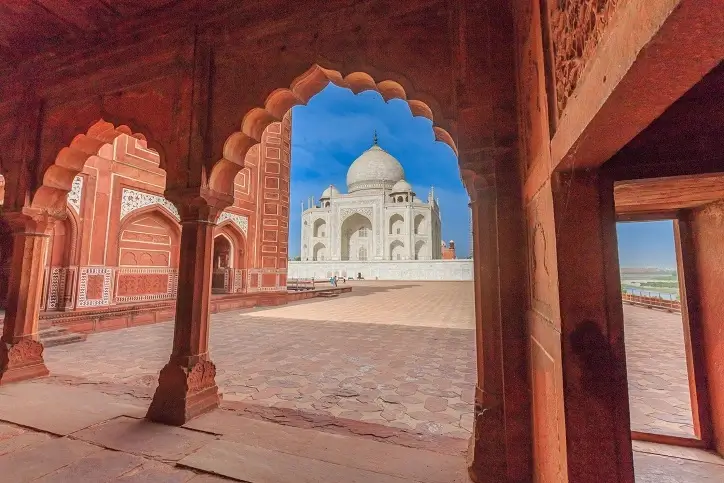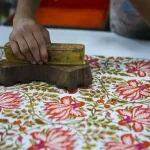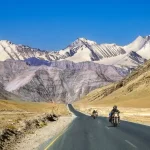India, a tapestry of diverse cultures, vibrant traditions, and historical landmarks, offers a travel experience. At the heart of this magnificent country lies the Golden Triangle. A tourist circuit that connects three of North India’s most famous cities: Delhi, Agra, and Jaipur. Each city is a cornerstone of India’s historical narrative, showcasing its rich past through monuments, cuisine, and living traditions.
Golden Triangle India refers not just to the geographical layout of these cities on the map, which forms a roughly equilateral triangle, but also to the wealth of cultural and historical splendor they possess. The India Golden Triangle is the gateway to India’s heart, pulsating with the rhythm of bustling markets, the whispers of ancient palaces, and the tranquility of sacred temples.
For those looking to explore this majestic circuit, custom tours tailored to personal interests and preferences are available, providing an intimate look at the Golden Triangle’s treasures.
As we lay out this journey for you, expect to delve into the intricacies of planning the trip. We’ll guide you through crafting the perfect itinerary, selecting the best modes of transportation, and choosing accommodations that offer a taste of Indian hospitality.
What is the Golden Triangle?
The Golden Triangle is more than just a popular travel itinerary; it is a passage through India’s heart, presenting the depth of the country’s heritage in a single sweep. This famed route earns its name from the triangular shape formed on the map by three of North India’s most culturally significant cities: Delhi, Agra, and Jaipur. When travelers speak of the Golden Triangle tour India offers, they reference a journey that encapsulates centuries of history, art, and architecture within its fold.
The Golden Triangle India tour is not just a geographical concept but a chapter of history etched onto the modern landscape. It’s where the past meets the present, and stories of empires, battles, love, and art come to life. The circuit covers approximately 720 kilometers by road, with each side of the triangle being about 4-6 hours’ drive apart.
For those looking to delve deeper, customized tours can offer a more intimate exploration of the Golden Triangle India. These personalized journeys allow for a closer look at the local way of life, offering opportunities to participate in traditional workshops, enjoy local cuisine, and engage with the people carrying forward the region’s customs and stories.
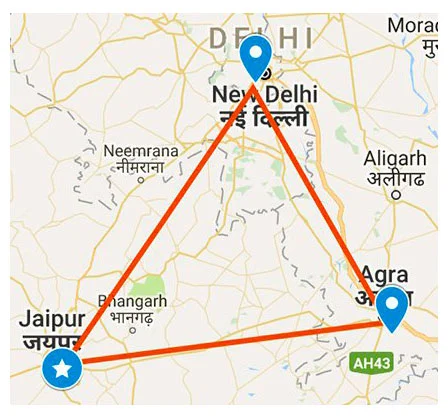
When embarking on a Golden Triangle tour India opens its treasure chest, revealing gems of historical grandeur, artistic prowess, and cultural richness. It is an experience at the top of the list for explorers of this diverse and fascinating country.
Where is the Golden Triangle?
The Golden Triangle India tour is named for the triangular shape formed on the map by Delhi, Agra, and Jaipur. It is a region steeped in history, rich in culture, and brimming with some of the most majestic landmarks the country has to offer.
These three cities, though distinct in their identities, are interlinked not just by geography but by the cultural legacies they share. Together, they form a compact circuit that provides an enriching experience of India’s diverse heritage.
Delhi serves as the perfect starting point for the Golden Triangle India tour. As a city continuously inhabited since the 6th century BC, it is a living museum. From here, the journey to the other two cities becomes a convenient and enlightening route into the heart of India.
Approximately 200 kilometers from Delhi is Agra, a city that rose to prominence during the Mughal era. The distance can be covered in about three hours by road or two hours by train, making it an accessible stop after Delhi.
Finally, Jaipur, around 240 kilometers from Agra, completes the triangle. Travelers often marvel at how the landscape transitions from the city of love to the pink city, where the air carries tales of Rajput valor and splendor.
While each city is a universe in itself, the Golden Triangle tour packages weave these disparate threads into a cohesive tapestry, showcasing the variety that India is famous for. The triangle not only connects the locations but also the past to the present, the rulers to the people, and the legends to the landmarks. Custom made tours often enhance the experience, allowing travelers to explore each city at their own pace, with itineraries tailored to their interests.
The Corners of the Triangle
Delhi – The Historical Capital
Delhi, the capital city, is often the starting point for the Golden Triangle group tour. It’s a city where time travels, revealing layers of history with every turn. Here, ancient forts and tombs stand amid the bustle of a metropolis. The Red Fort, with its imposing red sandstone walls, tells stories of Mughal emperors. Not far is the Jama Masjid, one of the largest mosques in India, inviting believers and travelers alike.
A walk through Old Delhi’s narrow lanes is an assault on the senses, filled with the aroma of street food, the cacophony of vendors, and a kaleidoscope of colors. Meanwhile, New Delhi, designed by British architects Lutyens and Baker, provides a stark contrast with its broad boulevards and grand government buildings. Delhi truly embodies the spirit of the Golden Triangle India boasts about, where each stone and spice has a history to share.
Agra – The Iconic Home of the Taj Mahal
The city of Agra is synonymous with the Taj Mahal, an edifice dedicated to love that draws millions from around the globe. However, Agra’s narrative runs deeper than this single monument. A former capital of the Mughal Empire, Agra’s heritage is also seen in the majestic Agra Fort and the ethereal Tomb of Itimad-ud-Daulah, often referred to as the ‘Baby Taj.’
Agra’s essence lies not only in its architectural wonders but also in its artisanal crafts. Marble inlay work, a skill passed down through generations, is still practiced with finesse, a testament to the city’s enduring artistic traditions. For travelers on a Golden Triangle India tour, Agra offers a profound understanding of how beauty can be etched in stone and stories.
Jaipur – The Pink City’s Royal Grandeur
Jaipur, the Pink City, is where regal India is at its most palpable. The city’s palaces and forts, painted in the earthy red and pink hues of local sandstone, speak volumes of the royal Rajputana legacy. The Hawa Mahal, City Palace, and Amber Fort are not just architectural marvels but living chronicles of a storied past.
Jaipur is also a cultural hub, famed for its jewelry, textiles, and handicrafts. The city’s bazaars brim with traditional products that carry the indelible mark of Rajasthani craftsmanship. Moreover, Jaipur is also making strides in preserving and promoting its cultural heritage through various festivals and events, making it an essential corner of the Golden Triangle in India.
For personalized exploration, customized tours in India are available, tailored to suit the interests of history buffs, art lovers, and adventure seekers. These tours can take one behind the scenes of the usual tourist spots to experience the local life and hidden gems of these cities.
Culinary Journey Through the Golden Triangle India
Delhi: A Melting Pot of Cuisines
Delhi, the starting point of many group tour packages, is a bustling metropolis with culinary influences. Here, food is an integral part of the city’s heritage, with street food stalls and high-end restaurants offering dishes that narrate the city’s history. From the tender kebabs of the Mughal emperors to the spicy street chaats, the city’s food scene is as dynamic as its populace.
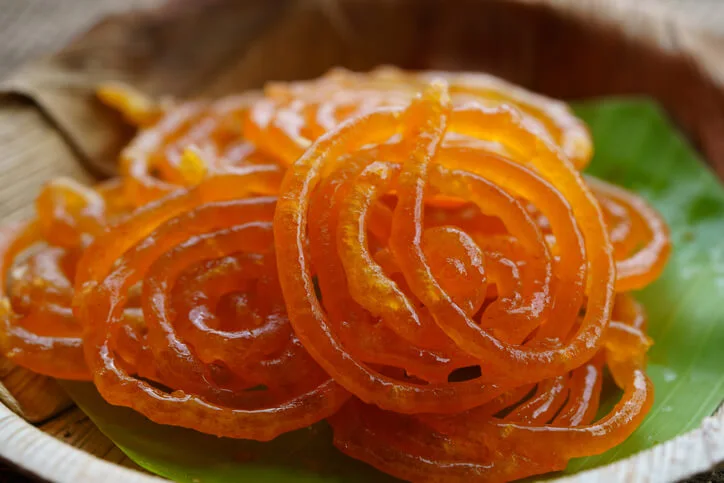
One must try the buttery parathas from the narrow lanes of Chandni Chowk, where each layer tells a story of tradition passed down through generations. Sampling the rich butter chicken, a dish rooted in the partition era, gives one a taste of the city’s resilience and innovation. Delhi’s food is a testament to its spirit, blending the old and new, just like the city.
Agra: Flavorful Legacies of Love
Agra’s claim to fame might be the Taj Mahal, but the culinary offerings in this city are no less monumental. A luxury Golden Triangle tour is incomplete without tasting the Mughlai cuisine that the city is famous for. The same love and finesse that went into building the iconic mausoleum can be found in the rich gravies and slow-cooked meats of Agra.
The sweet Petha, made from ash gourd, is a local delicacy that echoes the city’s sweetness and history. It is a must-try for those with a sweet tooth, available in various flavors, each telling a different story of the city’s confectionery artistry. Even the most unassuming eateries in Agra offer a royal feast, proving that you don’t need to dine like a king to taste the real flavors.
Jaipur: Royal Flavors Painted in Pink
Jaipur, the Pink City, is not only a spectacle for the eyes with its grand palaces and forts but also a haven for gastronomes. The traditional Rajasthani cuisine served on a group tour in India is a riot of colors and flavors, much like the city. The food here is an honest representation of its royal heritage, with dishes that carry the tales of warrior princes and their feasts.
The smoky flavor of Laal Maas, the signature meat curry, speaks of the boldness of the Rajputana clan. The sweetness of the Ghewar, resembling the honeycomb structures of the city’s architecture, offers a taste of Jaipur’s artistic excellence. Dining in Jaipur is like attending a royal banquet, with every dish crafted to perfection, befitting the city’s majestic aura.
When is the Best Time to Visit India’s Golden Triangle?
When planning a trip to this iconic trio of cities, timing is everything. The season you choose to visit can profoundly affect your experience, from the weather you’ll encounter to the festivals you may witness.
India’s climate is categorized into three main seasons: summer, monsoon, and winter. Each season casts a different hue over the Golden Triangle India.
Summer (April to June) is hot, with temperatures soaring above 40°C (104°F). If you don’t mind the heat, this is when you’ll find the Golden Triangle less crowded. Early mornings and late evenings are the best times for sightseeing.
Monsoon (July to September) brings rain, turning the landscape lush and zesty. However, travel can be unpredictable due to potential downpours.
Winter (October to March) is considered the prime time to visit. The weather is mild and conducive to exploring. With temperatures ranging from 8°C to 24°C (46°F to 75°F), outdoor activities are pleasant, and the skies are clear.
The optimal time to explore the Golden Triangle is from October to November or February to April, as the daytime weather is agreeable and cools off just enough in the evening to warrant wearing a light sweater if you’re outside. While December and January offer comparable daytime warmth, the temperatures at night can drop significantly. Additionally, there’s the possibility of encountering early morning fog during these months, which not only can conceal attractions but may also lead to railway schedule disruptions.
Ideal Itinerary: Balancing Climate and Crowd
To maximize your experience, a balance must be struck between pleasant weather and tourist traffic. The golden window for a Delhi Agra Jaipur tour is October to November and February to March. These months offer a blend of delightful weather and moderate tourist presence, making it easier to enjoy the landmarks without the peak season crowds.
For those seeking tailor-made tours, these periods allow for a customized tour package that can cater to personal preferences without the constraints of extreme weather or overbooked venues. Whether you’re after historical exploration, culinary adventures, or local interactions, planning during these months ensures a smoother and more personalized experience.
Golden Triangle tours are not just about the places; they’re about the times you visit them. A well-timed trip not only offers comfort but also the richness of India’s traditions in full swing.
How to Plan a Trip to Delhi, Agra, and Jaipur?
Crafting the Perfect Itinerary
When planning your Golden Triangle tours India, it’s crucial to allocate sufficient time to appreciate each city’s splendor. A comfortable duration for exploring the triangle is typically a week. In Delhi, you must witness the grandeur of the Red Fort, the tranquility of the Lotus Temple, and the lively lanes of Chandni Chowk. Agra’s crowning jewel, the Taj Mahal, deserves an unhurried visit, ideally at sunrise, to capture its beauty in the soft morning light. In Jaipur, the Amber Fort and City Palace are sights not to miss, offering glimpses into royal legacies.
Every ‘Delhi Agra Jaipur tour package‘ should allow two days in each city, with an extra day for any side trips or rest. Your itinerary should include not just landmarks but also hidden gems – like Delhi’s Lodhi Gardens, Agra’s Mehtab Bagh, and Jaipur’s step-wells – to truly grasp the essence of each locale.
Travel and Accommodation
Moving between cities in the Golden Triangle India can be an adventure. For a seamless experience, consider Luxury Private Tours India, which arranges comfortable vehicles for intercity transfers. Trains are a viable option as well, with the Gatimaan Express being a popular choice for the Delhi-Agra leg. For stays, the Golden Triangle offers a range from heritage hotels, capturing the region’s regal past, to modern accommodations providing contemporary comforts.
Tailor-made tours in India often include accommodations suited to your taste and budget, ensuring a hassle-free selection process. In Delhi, staying near Connaught Place offers proximity to both historical sites and shopping. In Agra, opt for a view of the Taj Mahal from your hotel window, and in Jaipur, the old city areas give you a traditional Rajasthani experience.
Cultural Etiquette and Tips
Understanding and respecting local customs is vital when traversing the Golden Triangle India. Dress conservatively when visiting religious sites, and always remove your shoes before entering. It’s wise to learn a few phrases in Hindi; a simple ‘Namaste’ can go a long way in showing respect.
Remember to stay hydrated, especially if you’re unfamiliar with the Indian climate. Always have bottled water, and be cautious with street food – though it’s delicious, it might not agree with every traveler’s stomach. Lastly, bartering is commonplace in local markets, so do not hesitate to negotiate prices.
The Golden Triangle Through a Photographer’s Lens
Delhi, the starting point for many journeys into the Golden Triangle India, blends eras. The grandeur of the Mughal architecture offers a rich tapestry for photographers. Equally compelling are the candid shots of local life in the bustling markets of Chandni Chowk. A Budget Golden Triangle tour of India doesn’t skip the opulence hidden in the simplicity of these historic sites.

Agra’s eternal symbol of love, the Taj Mahal, is a pinnacle for photography enthusiasts. Capturing the ivory-white marble mausoleum during different times can present a series of images, each with its mood and story, from the soft hues of dawn to the fiery sunset backdrop. Photographers can also delve into the lesser-known yet picturesque sites like the Agra Fort and Mehtab Bagh for unique perspectives.
Jaipur’s allure for photographers is unmistakable, with its forts and palaces illuminating the royal past. The Amber Fort, Hawa Mahal, and the City Palace are not just architectural marvels but also spectacles of history and art. A Golden Triangle tour guide can reveal the best spots to capture the essence of the Pink City, from the heights of the Nahargarh Fort to the lively chaos of the bazaars.
When on guided group tours, always be prepared. Early mornings often provide the best light and fewer crowds. Respect the local culture and seek permission before photographing people. A Golden Triangle tour guide will often have insider knowledge about hidden gems and the best times to visit each site.
Souvenirs and Memories: Taking a Piece of History Home
When shopping on the Golden Triangle tour of India, the choices are as diverse as the destinations. In Delhi, one can find everything from handcrafted artifacts to exquisite garments. The key is to choose items that resonate with your experience. From the colorful bangles of Jaipur to the intricate marble work of Agra, each souvenir tells a story.
Delhi offers an array of shopping experiences, from the traditional Chandni Chowk to the upscale boutiques of Hauz Khas Village. For those on corporate travel services, it’s essential to prioritize your shopping list. Delicate pashminas, vibrant textiles, and spices are not just purchases but memories you can carry back.
The city of the Taj Mahal is famous for its marble inlay work, with designs as intricate as the mausoleum itself. Shopping in Agra can be a delightful experience when you choose handcrafted marble souvenirs that reflect the Mughal influence on Indian craftsmanship.
Jaipur is a paradise for gemstone aficionados and textile lovers. The local markets teem with a stunning array of jewelry and fabrics, each piece showcasing the skill and tradition of Rajasthani artisans. Remember to negotiate with a smile, as bargaining is part of the shopping culture here.
When part of group tours in India, stick with your companions or inform your guide of your plans. Always be mindful of the authenticity of the items you purchase, especially for expensive goods like jewelry.
As you wind up your Golden Triangle India tour, the souvenirs you choose are not just items to display but embodiments of the experiences you’ve had. They are a way to share the story of your travels with friends and family. For those on a personalized 5 days Golden Triangle tour of India, the memories you make are as precious as the souvenirs you bring home.
Conclusion
Travelers who embark on the 3 days golden triangle tour witness the incredible array of historical marvels, from the majestic forts to the silent whispers of ancient palaces. Delhi, Agra, and Jaipur are cities where every corner has a story, every street holds echoes of the past, and every monument celebrates India’s artistic and architectural prowess.
It is this profound connection to history that makes the Golden Triangle India tour not just a vacation but a vibrant educational experience. With the growing popularity of the Golden Triangle tour, it’s crucial to advocate for sustainable and responsible travel. As explorers of such a cherished heritage, it is our responsibility to ensure that the beauty and integrity of these sites are preserved.
As we conclude our journey through the Golden Triangle India, let’s carry with us the awe and respect these timeless landmarks inspire. The essence of this adventure lies in its ability to bridge past and present, to merge the tales of bygone eras with our contemporary quest for meaning and connection.
If you’ve been inspired to experience the Golden Triangle for yourself, Custom Tours India invites you to reach out and let us help you craft an unforgettable journey. Our expertise and passion for India’s heritage can guide you through a travel experience that’s not only mesmerizing but also aligns with the principles of responsible tourism.

